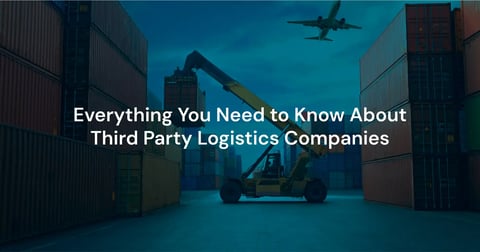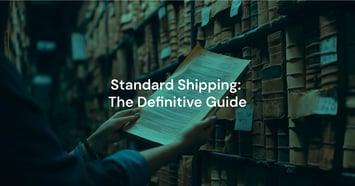Everything You Need to Know About Third Party Logistics Companies

Whether you’re a high-volume shipper looking to better manage fulfillment in specific geographic locations or a growing ecommerce brand that needs better product placement (but doesn’t have the capital to build warehouses nationwide), third party logistics (3PL) is the solution.
Let’s review what third party logistics companies are, their scope of services, and how to choose the right partner for your business.
What are third party logistics?
Third-party logistics is the outsourcing of logistics functions like warehousing, transportation, and inventory management to a specialized third-party company. This strategy enables enterprises to access ecommerce supply chain expertise and established shipping networks.
Particularly advantageous to mid-sized businesses, 3PL companies operate by building networks of warehouses, carriers, and technology systems to manage multiple clients' logistics needs simultaneously. This shared infrastructure offers economies of scale through collective shipping volumes and established carrier relationships.
More and more businesses are seeing value in working with third party providers. In fact, the global 3PL market is expected to grow from $1.14 trillion to $2.54 trillion between 2024 and 2032, representing a CAGR of 10.5%.
Primary services offered by 3PL providers
In many ways, third party logistics operates as a one-stop shop for supply chain operations, offering everything from last mile delivery that helps enterprise operations cut time-in-transit to full-blown warehousing for businesses that don’t yet have dedicated fulfillment centers.
Warehousing and fulfillment
3PL partners can store products, manage inventory, and handle order processing — from picking and packing boxes to actual shipping. This comprehensive approach speeds up order processing and helps you deliver products to customers more efficiently.
Transportation management
Transportation management services move orders efficiently from pickup to delivery. From selecting carriers to optimizing routes, these services help businesses cut costs while getting products to customers on time.
Freight forwarding
Freight forwarding moves products across international borders. Using 3PL delivery services to coordinate air and ocean logistics, consolidate shipments, and handle international shipping compliance saves time and money.
Customs brokerage
Customs brokerage helps navigate complex international trade rules. Your 3rd party shipment service can manage customs clearance, documentation, taxes, and compliance requirements to keep your international shipments moving smoothly.
Reverse logistics
Reverse logistics handles product returns from start to finish. The 3PL service receives returned items, restocks sellable products, and processes exchanges or refunds. A smooth returns process keeps customers happy while minimizing losses.
Shipping services
3PLs offer multiple shipping methods that can be customized to your volume, speed, and cost requirements. This flexibility allows businesses to optimize their shipping strategy as needs change.
Types of 3PL shipping services include:
- Dedicated contract carriage (DCC): Private fleet solution where vehicles and drivers are assigned exclusively to your shipping needs, ensuring reliable capacity and consistent service. For instance, a large retailer shipping daily deliveries between their regional distribution centers and stores would benefit from dedicated trucks and drivers.
- Less-than-truckload (LTL) shipping: Cost-effective shipping for mid-sized shipments that combines your freight with other shippers to maximize truck space efficiency.
- Full truckload (FTL) shipping: Exclusive truck use for your shipment provides faster delivery times and enhanced security for larger orders by avoiding multiple stops. This option helps to ship inventory to a fulfillment center or ensure the safety of temperature-sensitive goods requiring dedicated transport.
- Intermodal freight transportation: Dynamic service that uses multiple transportation methods like trucks, trains, and ships to optimize shipping costs and reach diverse locations. For example, shipping containers of products from Los Angeles to New York might travel by truck to a rail yard, by train across the country, and then by truck for final delivery.
- Parcel shipping: A standard shipping service for small packages and lightweight items — usually leveraging a network of carriers like UPS or FedEx for reliable delivery directly to customers’ homes.
Benefits of using third party logistics
Using a 3PL service offers benefits for both mid-sized businesses and high-volume enterprise operations:
|
Third party logistics benefits |
How these 3PL benefits enhance your business |
Scalability |
Adjust operations up or down based on demand without investing in warehouse space, equipment, or additional staff. |
Cost savings |
Get comprehensive rate shopping via established carrier relationships while eliminating fixed warehousing and staffing costs. |
Time savings |
Focus on core business growth while experts manage logistics operations and shipping processes. |
Regional expertise |
Leverage established regional networks that offer faster routes with shorter delivery times. |
Technology access |
Gain access to enterprise-grade technology systems without the cost of building and maintaining infrastructure. |
How to choose the best 3PL partner
When selecting the best third party logistics provider for your business, follow these five steps:
1. Review your business needs
Analyze your current shipping process and document what is and isn’t working. While reviewing, consider:
- Your current order volume
- The types of products you ship
- How busy seasons affect your operations
- Plans in place for future growth
These insights will help you pick 3PL logistics solutions that resolve your pain points and accommodate your business as markets shift.
2. Evaluate 3PL capabilities
Assess the range of general and value-added services, including warehousing, transportation, and inventory management. Examine their technology infrastructure, such as warehouse management systems (WMS) and real-time tracking capabilities, to ensure they align with your operational requirements and allow you to offer a great customer experience.
3. Assess industry experience and customer references
Look for 3PLs with proven experience in your industry. Request case studies and client testimonials, and don't hesitate to contact their existing customers for feedback on performance, reliability, and problem-solving abilities.
4. Consider geographical reach and distribution network
Review where the 3PL's warehouses and distribution centers are to make sure they effectively cover the target markets where your customers live. Check which shipping carriers they work with and whether they can handle domestic and international shipping if your business needs it.
5. Review pricing structure and contract terms
Examine pricing models based on transactions, space utilization, or both. Consider the contract terms, including service level agreements (SLAs) and performance metrics.
Manage your 3PL service providers with Shipium
Enterprise shippers work with multiple 3PL providers to ensure reliable service and reduce risk across their markets. With Shipium, you can automate:
- Shipment orchestration: Our Fulfillment Engine routes every order to the best warehouse for processing.
- Service provider management: Carrier Selection identifies the right carriers to fulfill orders on time at the best possible price.
You can reduce costs and boost profits by reducing your delivery times and consistently ensuring your business uses the most cost-effective shipping methods. In fact, according to a report by Nucleus Research, customers who use our platform reduce their parcel spending by an average of 10%.
Book a demo today to explore how Shipium can help you better manage your third party logistics companies.
Frequently Asked Questions
How does a 3PL solution help me reduce my shipping costs?
3PL service providers reduce shipping costs through established carrier relationships, shared volume discounts, and optimized route planning. They help you choose the most cost-effective delivery options while efficiently consolidating shipments.
Will my current 3PL service provider be compatible with Shipium?
Yes. Shipium is designed to integrate seamlessly with most 3PL providers through our standardized API connections and flexible integration options. Our platform works alongside your existing relationships, providing enhanced visibility and performance analytics across your network.
See how Shipium’s integration framework connects with your existing systems.
Should I use multiple 3PL companies to manage my logistics?
Yes. Using multiple 3PL and LSP service providers makes sense as your business grows. Each provider brings different strengths to the table. For example, some excel in certain regions, while others specialize in specific services or industries. Working with many partners helps you get the best rates and reduces dependency on a single provider.

Diagonal thinker who enjoys hard problems of any variety. Currently employee #5 and the first business hire at Shipium, a Seattle startup founded by Amazon and Zulily vets to help ecommerce companies modernize their supply chains. Previously was CMO at Datica where I helped healthcare developers use the cloud. Prior to that I came up through product and engineering roles. In total, 18 years of experience leading marketing, product, sales, design, operations, and engineering initiatives within cloud-based technology companies.


